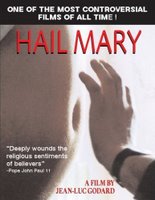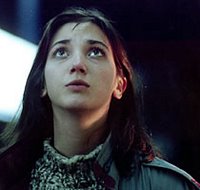Je vous salue, Marie (Hail Mary-1985)

Jean Luc Godard had been established as one of the masters of cinema for over thirty years by the time he wrote, directed and produced his fascinating exploration into the nature of the incarnation in 1985. Godard began as a writer for "Cahiers du Cinema" in the early 50s before graduating to making his own films from 1955 and becoming the most recognisable name amongst the directors of the French New Wave.
If, by the time the eighties came around, his output had begun to wane and lose a little of his early vitality, there was no shortage exploring ideas; It's no coincidence that his adaption of a key story from the Bible was followed by his re-working of King Lear (1987) and notable too is the film's repeated use of the historic-sounding intertitle "At that time" (Godard's interplay between the written text of intertitles and visual image is one of the most striking features of his body of work).
In essence the idea is a simple one - telling the story of Mary the Mother of Jesus as if it were to happen today - but hanging on that premise is the exploration of a number of themes including Marie's obsession with her changing body, her struggle to persuade Joseph of the baby's divine origin, her continued virginity, the contrast between the profane and the divine, the idea of a godly figure born into such a lowly background and Marie's struggle to come to terms with her new, and constantly evolving, roles. Many of Godard's films give an importance to, and occasionally verging on the deification of, his female leads. Indeed as David Thomson puts it "It was the discovery that he loved [actress Anna] Karina more in moving images than in life that may have broken their marriage".1 Hardly surprising, then, that eventually he would turn his attention to the mother of God.
As those familiar with Godard's work might expect there's no shortage of cinematic concepts and contrivances. Those familiar with Il vangelo secondo Matteo by Pier Paolo Pasolini, who collaborated with Godard on 1962's RoGoPaG with Godard, will recognise that Godard uses the same part of Bach's St Matthew's Passion as his Italian counterpart. Godard also plays around with the continuity of his editing, focussing for long stretches on single scenes, or even shots before jumping ahead several days, months or even years. And then there's his characteristic humour for example towards the end of the film Marie's child, who has now grown to the age of young school child, asks a new-found friend his name and then proceeds to change it to Peter.
From a visual point of view the film is shot in the 1.37:1 that he favoured at the time. Godard uses this more equally-proportioned canvas to focus attention on an array of circular objects, most notably the full moon and the seemingly enlarged sun of numerous shots; the basketballs that Marie and her team-mates use to play; as well as a glowing spherical light shade, which sticks out from the edge of one shot like a huge white pregnant tummy, dominating the screen. Reflections of the sun's light are everywhere from the opening shot of sunlight skipping across ripples of the water's surface, to eighteen shots of the moon, "a Marian symbol of virginity and femininity".2
Not dissimilarly there is a lot of talk about "holes" and it's notable that the film ends on an extreme close up of Marie's lips; freshly glossed and open in a circle as if signifying that now Jesus reached a certain age she is finally sexually available. Indeed just a scene or two earlier had been Jesus telling his mother he is going to do his "father's work" and we don't see him again.

But the film's most central visual theme is the body of Marie herself as the camera focuses on her naked body in scene after scene. The intention of this seems to be to focus on the idea of Mary's own confusion and conflicting emotions about her body being taken over by this patriarchal God. As Godard later explained "I was trying to make the audience see not a naked woman, but flesh, if that's at all possible"3. However despite his claim that his "purpose was to try and shoot a woman naked and not make it aggressive, not in an X-rated picture way...more the purpose of an anatomical drawing."4, the film quickly becomes uncomfortably voyeuristic. Given that the subject of this voyeurism is a teenage schoolgirl, these shots, in light of present day attitudes, make these scenes all the more problematic.
The degree of nudity in the film may well be why it received such heated criticism from many quarters. Pope John Paul II allegedly claimed it "deeply wounds the religious sentiments of believers" - although I can find no original source for this quotation even if it did cheekily appear on the cover of one of the film's DVD releases - and it was banned in Brazil and Argentina. Indeed Godard himself tried to withdraw the film from distribution in Italy and was personally attacked (albeit with a shaving-foam pie in the face) when the film screened at Cannes.5.
Nevertheless, I'm always struck by the fact that this film is, theologically speaking, very conservative. It clearly pre-supposes that Mary is a virgin before and during her pregnancy and yet was banned and heavily criticised. In contrast, just four years later the far more revisionist and critical Jesus of Montreal was given the Cannes Ecumenical Jury prize, as voted for by religious representatives. The most likely explanation is that this is due to the film's heavy focus on Mary's naked body. Perhaps this at least, a victory of images over script, may have given Godard some pleasure.
At its heart there is an interesting question - "How would Mary have felt about the changes to her body throughout her pregnancy?" After all the giving of her consent was momentary, but she paid a high cost for that over the next nine months, and forever after. As Marie herself says at one point "Being a virgin should mean being available or free, not being hurt". Many expectant mothers feel a degree of animosity about the difference between their initial expectations about pregnancy and the reality. It's more than possible that Mary's attitudes also swung back and forth a fair bit, as we see here in the scene of Mary's "long dark night of the soul". Nevertheless the way the film explores these issues fails to draw them out as well as it might have.
None of which is to say that there is a shortage of ideas in the film. Indeed there's no shortage either of the kind of philosophising that was so typical of the French New Wave. Early on a professor tells his class "The astonishing truth is that life was willed, desired, anticipated, organised, programmed by a determined intelligence" and the film in general seems to move between an acceptance of God's existence but a rejection of his methods. In one of Marie's lengthy monologues she mutters "God's a creep, a coward who won't fight, who counts on ass alone...a vampire who suffered me in him".
The use of "vampire" here is probably a reference to Dreyer's 1932 Vampyr. As is typical of Godard Hail Mary cites the work of numerous artists including Dreyer. As Marie gives birth to Jesus we hear a man speak the words "What a strange road I had to take to reach you". It's a quote from the final scene of Robert Bresson's Pickpocket and it's followed up almost immediately by a shot of a donkey, doubtless referencing Bresson's Christ-figure film Au Hasard Balthazar. There's even a shot of Mary posed like Mantegna's painting "Lamentation of Christ".
But Mary's language here is also an example of the way the film plays the sacred against the profane. "Here's $500 for God's sake" says Gabriel to persuade Joseph to drive him to the petrol station where he delivers the annunciation under the unblinking light of the forecourt. It's clear that this Mary will remain as chaste as the biblical Mary, even as her use of swear words sets her apart from the Mary of church tradition. All the leading characters, be they saints in waiting or angels, swear or take the name of God in vain. Confronted with the news of Mary's pregnancy, Joseph blames "Guys with big cocks". Mary uses the "c" word as she wrestles with God's unusual calling.
Gabriel is accompanied here and elsewhere by a young girl. The pair reappear miraculously later in the film - emphasising their divine mandate - and Gabriel appears once more at the film's close. Also making an appearance is a character called Eva, her biblical significance underlined by her taking a bite from an apple close to the camera. She is contrasted with the chaste Marie, in a similar fashion to 1 Tim 2 contrasts Mary and Eve. Eva gives herself freely but is left alone towards the end. Mary stays with Joseph ans takes pride in her son. Many Annunciation paintings represent the Garden of Eden around the peripheries of the main picture and here the inclusion of this seemingly unconnected story works in a similar fashion.6
This constant attention to, referencing of and subversion of Christianity's visual traditions is what sets Hail Mary apart from so many other Bible films. Godard my only have been grabbing headlines on this production due to the ensuing controversy, rather than his artistry, but the fingerprints of a great master are all over this piece. Even if we're ultimately forced to concede it's far from his best work.
Je vous salue, Marie (Hail Mary, 1985) - Frequently accompanied by The Book of Mary by Anne-Marie Miévielle
====================
1 - Thomson, David, The New Biographical Dictionary of Film, (4th Edition, 2003) Little, Brown. p.342
2 - O'Brien, Catherine, "The Celluloid Madonna: From Scripture to Screen" (2011) New York, Columbia University Press, p.137
3 - Dieckmann, Katherine in Sterritt, David, "Jean-Luc Godard: Interviews" (Jackson, 1998) p.169
4 - Dieckmann, p.169
5 - "Godard Has A Bad Day In Cannes...And Tries To Withdraw 'Hail Mary' In Italy", Aljean Harmetz, The New York Times, 11th May 1985
6 - O'Brien, p. 45
Labels: French Bible Films, Hail Mary, Nativity - Mary Joseph




















